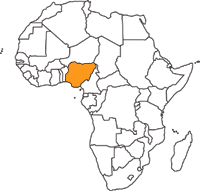 |
National Parks
- Baturiya Wetlands
- Chad Basin
- Cross River
- Cross River (Oban Division)
- Gashaka-Gumti
- Gujba
- Ifon
- Kainji Lake
- Kamuku
- Kogo
- Kuyambana
- Old Oyo
- Sambisa
- Yankari
Strict Nature Reserves
- Akure
- Bam Ngelzarma
- Bonu
- Lekki
- Milliken Hill
- Omo
- Ribako
- Urhonigbe
Game Reserves
- Akpaka
- Alawa
- Anambra
- Ankwe River
- Bakono
- Baturiya Wetlands
- Dagida
- Dagona
- Damper Sanctuary
- Ebbe/Kampe
- Falgore (Kogin Kano)
- Gilli-Gilli
- Ibi
- Ifon
- Iri-Ada-Obi
- Kambari
- Kashimbila
- Kuyambana
- Kwale
- Lame-Burra
- Margadu-Kabak Wetlands
- Meko
- Nguru/Adiani Wetlands
- Num River
- Ohosu
- Okeleuse
- Okomu
- Ologbo
- Opanda
- Opara
- Orle River
- Pai River
- Pandam
- Sambisa
- Stubbs Creek
- Taylor Creek
- Udi/Nsukka
- Wase
- Wase Rock Bird
Wetlands of International Importance (Ramsar)
- Nguru Lake (and Marma Channel) complex
World Heritage Convention
UNESCO-MAB Biosphere Reserves
- Omo Strict Natural Reserve
|
|
Info
|
Protected Areas in Nigeria
The protection of wildlife began with the creation of Nigeria, soon after the amalgamation of the northern and southern parts of the country in 1914. Regional game laws were enacted, initially by eastern Nigeria in 1916 and later by the western and northern regions in 1928 and 1963, respectively.
The three categories of protected area recognized within the wildlife sector are strict nature reserve, game reserve and national park, all of which were formerly reserved forest.
In the late 1980s, the Federal Natural Resource Conservation Council (NRCC) was created. This Council is chaired by the President with representatives from a number of Ministries and from the Nigerian Conservation Foundation. This Council provides coordination for the conservation of natural resources, develops policies, can take direct measures to secure the status of species and sites, monitors conservation activities within the forestry and wildlife sectors, and provides funds for conservation and research work.
At the national level, the mandate for wildlife conservation and protected areas management is the responsibility of the Federal Department of Forestry in the Ministry of Agriculture, Water Resources and Rural Development. Within this Department, is the Division of Wildlife and Conservation, which is responsible for wildlife development and extension, and the enforcement of international wildlife conventions.
In Nigeria there are also 966 Forest Reserves.
Sources: UNEP-WCMC, World Database on Protected Areas
|
|


